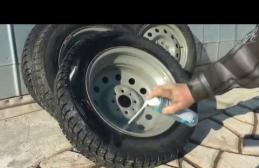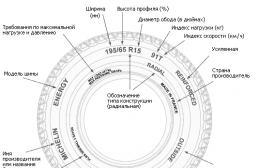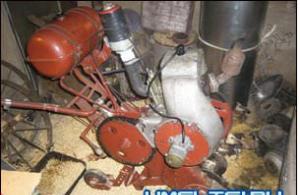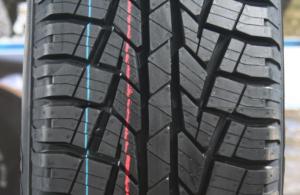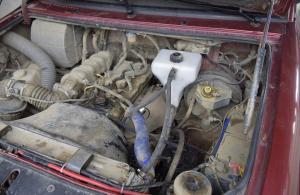The brake force distribution system is designed to prevent locking of the rear wheels by controlling the braking force of the rear axle.
A modern car is designed so that the rear axle has less load than the front. Therefore, to maintain the vehicle's directional stability, the front wheels must be locked before the rear wheels.
When the vehicle is braked sharply, the load on the rear axle is additionally reduced, since the center of gravity is shifted forward. And the rear wheels, in this case, may be blocked.
The brake force distribution system is a software extension of the anti-lock braking system. In other words, the system uses the structural elements of the ABS system in a new way.
Common trade names for the system are:
- EBD, Electronic Brake Force Distribution;
- EBV, Elektronishe Bremskraftverteilung.
The principle of operation of the brake force distribution system
The EBD system, like the ABS system, is cyclical. The cycle of work includes three phases:
- retention of pressure;
- pressure relief;
- increase in pressure.
The ABS control unit compares the braking forces of the front and rear wheels using the wheel speed sensors. When the difference between them exceeds a predetermined value, the brake force distribution system is activated.
Based on the difference in the sensor signals, the control unit determines when the rear wheels are locked. It closes the intake valves in the rear brake cylinder circuits. The pressure in the rear wheel circuit is kept at the current level. The front wheel intake valves remain open. The pressure in the circuits of the brake cylinders of the front wheels continues to increase until the front wheels begin to block.
If the wheels of the rear axle continue to block, the corresponding exhaust valves open and the pressure in the circuits of the brake cylinders of the rear wheels decreases.
When the angular speed of the rear wheels exceeds the set value, the pressure in the circuits increases. The rear wheels are braked.
The work of the brake force distribution system ends when the front (driving) wheels begin to block. In this case, the ABS system is activated.
The modern car is literally crammed with various stabilization and safety systems. The principle of their work is such that they simply cannot do without a staggering number of electronic filling for their proper functioning. The topic of today's article is the EBD brake force distribution system. We will talk about the advantages of the principle of operation that the system possesses, and we will give an exhaustive answer to the question of how it works.
Main advantages
The EBD system is a fairly new technology, if, of course, we compare it with the classic ABS system, which has been installed on production cars for the past three decades. EBD appeared in the early 90s, and for the first time it was used on foreign cars.
The emergence of such a system was prescribed by those who ensure the safety of traffic on public roads. After analyzing the statistics, the engineers found out that the ABS does not solve the problem of preventing skidding, and the braking distance is not always shortened.
This is precisely what required the development of a brake force distribution system that would solve most of the problems that a driver might have during the next emergency braking.
What are these problems? The fact is that when the car starts to brake sharply, a load of different forces falls on its wheels. At the same time, even in a car equipped with an ABS system, the braking force on all four wheels will be the same.
But do not forget that different loads have been placed on the wheels. This will lead to the fact that one axle will slip, while the other, the grip of which is slightly higher, will already be blocked. This will shift the drag force that is applied to the car and the car will eventually deploy. There is no need to remind once again that this threatens an accident and loss of control, which is especially important when moving on slippery surfaces, be it ice or wet asphalt.
The EBV system is designed to distribute braking forces in a strictly defined way. Their distribution occurs in such a way that the wheels that have the least adhesion to the road will receive the least braking force, which will lead to the absence of blocking and subsequent skidding.
The wheels that grip the tarmac best will take a lot of effort to brake. Ultimately this will cause all four wheels to brake equally. Due to this, the safety of the driver and passengers will increase many times, and braking will occur more comfortably and predictably.
Detailed view
The principle of operation of such a system is quite simple. The entire functional unit consists of only three blocks, which are connected in series with each other and function synchronously. So, without fail, special valves are installed on the machine, which can be adjusted using a servo drive or hydraulically. The principle of operation of these valves is such that when an electrical impulse is applied, they can open or close in a certain way, regulating the pressure of the brake fluid.
The opening of the valves is controlled by the control unit, the operating principle of which is based on the use of a board and software embedded in it. The unit receives signals from sensors that are connected to the wheel hubs and estimates the speed of their rotation at the moment when the brake pedal was pressed.
Due to this, the system works constantly, because the control unit and sensors become active exactly at the moment when the driver starts the engine. This ensures that the driver and passengers are always safe, and braking does not become an unpleasant surprise that can lead to an accident.

Summary
The brake force distribution system is a powerful tool that greatly increases the safety of the driver and passengers. The use of such a system leads to the fact that the car becomes more predictable on the road, and braking does not turn into a dangerous skid, which can lead to sad consequences.
For a long time, the automotive industry has supplied vehicles based solely on the laws of mechanics. Today it is almost impossible to meet a modern car that will not be stuffed with a large number of computers and various auxiliary electronics. In other words, nowadays, most safe cars are 50 percent driven by artificial intelligence.
This applies in particular to vehicle safety systems. Every year the systems of braking, anti-blocking, traction control of wheels are becoming more advanced and high-tech, ensuring safe driving even for beginners.
One of the revolutionary innovations at one time was the EBD system, which is responsible for the distribution of braking forces.
The brake distribution system or Electronic Brake Distribution (EBD) was first used in the early nineties of the last century. Even then, most car manufacturers accepted the fact that their ABS systems did not give one hundred percent results in terms of completely unlocking the wheels while driving. This was especially striking when it came to the distribution of the load on the brakes of the front and rear wheels. ABS easily coped with unlocking the front wheels, but the rear more often could not be unlocked, which instantly led to a dangerous turn of the car while driving at speed.
After years of research, it was found that all wheels receive the same braking load. But the problem was that they were all in different conditions and had different grip. Thus, under the same load, all four wheels could behave completely differently, creating an emergency situation while driving. The front ones could be unlocked, giving the driver more control over the car, but the rear ones, which could not be unlocked, completely neutralized the effect, sending the car into a skid. To solve this complex problem, the EBD system was created - an electronic brake force distribution system.
Today EBD can significantly improve vehicle handling and is indeed capable of returning control of the vehicle to the driver. Thanks to this system, the trajectory of movement is maintained, the degree of likelihood of skidding is reduced, even on slippery surfaces. Electronics easily determines how great the grip is, on which surface the movement is taking place. After that, there is a direct distribution of braking forces, which allows you to remove the braking load from wheels that have good adhesion.
The whole system is built on the work of three basic basic elements. The first is sensors that take into account how fast the wheels are spinning. The same sensors are used by the ABS system to obtain the necessary information. The second element is the brake line valve system, which consists of pressure reducing and non-return valves. The third is the ABS control unit, with which EBD is inextricably linked.
The essence of the work lies in the timely receipt of signals from the ABS and the correct response to them. As soon as the vehicle is in emergency braking, the ABS is activated. At the same moment, the work of the brake force distribution system begins, which, taking all the necessary data from the sensors, determines how fast the car's wheels are spinning.
After receiving and processing the data, EBD calculates which wheels have normal traction and which do not. After that, the distribution system itself comes into force - signals are sent from the unit to the valves, which are responsible for regulating the pressure in the car's brake system. They distribute the braking force so that the front wheels receive less braking force. Most of the effort goes to the rear wheels. This achieves the effect of equalizing forces, which improves handling, grip and regain control of the car to the driver, thereby preventing an emergency situation.
At the same time, the ABS continues to work, which, focusing on the data on the correctly distributed braking force, begins to unlock the wheels. Often this allows (in 99 percent of cases) to avoid a collision of the car with an obstacle on the way.
What is the difference between ABS and EBD? The answer is pretty simple. If the ABS only works at certain points in time, then the brake force distribution system is always on. It processes all the data of the braking system every second, "understanding" also the surface on which the vehicle is moving. That is, in fact, the system works even in those moments when there is not even a hint of an emergency, constantly processing data from sensors in the braking system. At the same time, in modern cars, ABS and EBD are two safety elements that work not so much in conjunction as complement each other.
No matter how it sounds, at the moment there is simply nothing to say about the shortcomings or disadvantages of the brake force distribution system, since in fact there are none. On the other hand, there are several advantages to using EBD.
First of all, this system provides the safest driving experience even on difficult surfaces. The driver does not have to worry about being blown off the road or turning him around while driving on very slippery asphalt.
EBD shows excellent results both when braking on a straight line and during emergency braking during a sharp turn or dangerous skid. Moreover, in the second case, modern systems are able to distribute the braking force not only between the front and rear wheels, but also focusing on the situation and the drift angle, between the inner and outer pair of wheels, providing a quick return of control over the car to the driver.
In many modern cars, a huge number of abbreviations are indicated in the "equipment" section. And if a fairly large number of people know what ABS is, then how the electronic brake force distribution system EBD EBV works, few are devoted to the intricacies of the car's EBD system.
So, EBD is a brake force distribution system. It is needed in order to prevent the rear wheels from blocking. EBD manipulates the force on the rear axle. The question immediately arises, why is this necessary? The fact is that many modern cars receive a much greater load on the front axle than on the rear. That is why the front axle lock should come a moment earlier, which will allow the car to maintain directional stability. At the moment of very sharp braking, the above force increases due to the movement of the center of gravity of the machine. This leads to incorrect operation of the usual ABS. Thus, EBD is an excellent addition to the standard "traction control".
There are two common abbreviations for the brake force distribution system:
- EBD - comes from the English language "electronic brake force distribution".
- EBV - German variant, found mainly in cars from Germany "Elektronische Bremskraftverteilung".
EBD EBV Working Principle
Just like its older brother ABS, EBD has a kind of cycle in which the system works:
- The first phase is holding pressure.
- The second phase is pressure reduction.
- The third phase is to re-set the desired pressure.
This system starts working after the ABS control unit, having analyzed the information from the sensors on both axles, determines that the forces on both axles are not equal. It is the difference in these readings that shows when the rear axle lock starts. This is followed by the timely closure of the brake system valves leading to the rear axle. The pressure remains constant. This is "retention".
In the event that the above did not help and the wheels are still blocked (skidding), the system sends an impulse to open the exhaust valves, which allows the pressure to be reduced. This is phase number 2.
The turn of the last phase occurs when the angular speed of the rear axle wheels exceeds the set limits. Then the pressure is intentionally increased. After that, as a rule, a redistribution of efforts occurs, and the front wheels begin to block. At this point, the ABS system comes into play.
The ABS system, which has such a good track record: does not allow the wheels to lock, provides excellent handling and effective braking on slippery road surfaces, also has significant disadvantages.
But it doesn't matter if the car is also equipped with another system - EBD (Electronic Brakeforce Distribution), which copes well with compensating for the shortcomings of ABS. So how does the brake force distribution system work and why is it needed?
What is ABS? And what are her shortcomings?

Anti-lock braking system per second can make 15 to 25 cycles slowdowns. Even a mega pro in the field of extreme driving, due to physical factors, is not able to perform more than 5 brakes per second.
The task of ABS is to convert constant pressure on the brake pedal by the driver into periodic pressure, which allows you to maintain control of the vehicle. That is, the main task of ABS is to maintain controllability.
Yes, ABS is an excellent protection against "fools" and a solid support for inexperienced beginners, but there are also disadvantages:
During the operation of the system, it is difficult to calculate and predict when it will stop, because braking is actually not controlled by the driver;
There may be delays in the activation of ABS, because for correct operation, it must conduct a test of the road surface and calculate the coefficient of adhesion of the tires with it. This is possible on slippery roads when driving at speeds over 130 km / h. It is important to know this in order to be prepared and not get confused, thinking that the brakes have failed!
If there is a frequent alternation of uneven and uneven road surfaces, the system may not always react correctly at what moment and for which road to calculate the correct coefficient of adhesion;
If the car has jumped, the system suspends the braking force. This can lead to a sudden de-coordination of the driver when the ABS is inactive;
Anti-lock braking system eliminates even the smallest attempts to block the wheels, which can cause discomfort on loose and loose surfaces;
ABS completes its function at speeds up to 10 km / h. Yes, this is the norm for passenger cars, but if we take into account heavy vehicles, for example, cash-in-transit or representative armored vehicles, then a distance of up to one and a half meters to the braking distance can be added, which can clearly lead to an accident.
How ABS works
The ABS in the way of its work is somewhat reminiscent of the behavior of an experienced driver behind the wheel of a car. For example, on an ice surface, when you need to intermittently brake, keeping the wheels on the verge of blocking. In addition to all this, ABS evens out the work of the wheels, automatically adjusting the braking forces. This happens at a level that the car does not lose its directional stability.
 The complexity of technical execution does not extend to the principle of operation of this system. After the driver presses the brake pedal, the brake fluid is applied to the wheel brakes. In the place of contact of automobile wheels with the road surface, braking forces begin to appear. If you continue to press the pedal, the braking effect will certainly increase, but only up to a certain point... If the braking pressure is further increased, then positive results should not be expected, since the wheels are simply blocked, their rotation stops, and sliding, on the contrary, increases, although the effect of the braking forces remains at the same level.
The complexity of technical execution does not extend to the principle of operation of this system. After the driver presses the brake pedal, the brake fluid is applied to the wheel brakes. In the place of contact of automobile wheels with the road surface, braking forces begin to appear. If you continue to press the pedal, the braking effect will certainly increase, but only up to a certain point... If the braking pressure is further increased, then positive results should not be expected, since the wheels are simply blocked, their rotation stops, and sliding, on the contrary, increases, although the effect of the braking forces remains at the same level.
As a result, the car becomes almost impossible to drive. ABS is doing everything necessary so that you simply avoid such a development of events. Having received the signals from the sensors and correlating them as needed, the ABS control unit commands the control valve to reduce the fluid pressure in the brake system, no matter how hard you press the brake pedal. Important in the principle of ABS operation and that the system individually determines the braking of each wheel that started experiencing blocking. When the situation has stabilized and the blocking probability has passed, the brake fluid pressure is normalized to avoid underbraking the wheels.
Every driver needs to know the difference between driving a car that is equipped with ABS and a car without this system. When driving a car with ABS, feel free to press the brakes, the wheels will not lock. Sometimes for drivers who have moved from old cars to models equipped with ABS, the process of getting used to it is not easy. After all, earlier it was necessary to “play” with the pedal, but now you just need to press the brake to the floor.
How EBD Works
 EBD monitors the distribution of braking force on all wheels. It operates on the data provided by the ABS unit. Each wheel of a car with EBD installed is equipped with sensors that transmit the wheel speed by means of electrical signals. Also, system sensors read the pressure in each wheel, determining how much the car is loaded. In general, EBD has data on how fast the car is moving, how loaded it is and how good the contact of the wheels with one or another road surface is. The big plus is that the data is read separately and independently from each wheel. This allows you to distribute braking actions as correctly as possible, avoiding losses in control.
EBD monitors the distribution of braking force on all wheels. It operates on the data provided by the ABS unit. Each wheel of a car with EBD installed is equipped with sensors that transmit the wheel speed by means of electrical signals. Also, system sensors read the pressure in each wheel, determining how much the car is loaded. In general, EBD has data on how fast the car is moving, how loaded it is and how good the contact of the wheels with one or another road surface is. The big plus is that the data is read separately and independently from each wheel. This allows you to distribute braking actions as correctly as possible, avoiding losses in control.
 How EBD works can be summed up in a simple tug-of-war example. As long as both teams are making an equal effort to tug the rope, the rope is in an immovable position. But if at least one competitor folds his hands, most of the rope will be on the side of the opponents. The analogy is visible in the case of EBD. In order to prevent the car from falling into a skid, the electronics evenly distributes forces to help the weakened wheel, if necessary, weakening others.
How EBD works can be summed up in a simple tug-of-war example. As long as both teams are making an equal effort to tug the rope, the rope is in an immovable position. But if at least one competitor folds his hands, most of the rope will be on the side of the opponents. The analogy is visible in the case of EBD. In order to prevent the car from falling into a skid, the electronics evenly distributes forces to help the weakened wheel, if necessary, weakening others.
Difference between ABS and EBD
 EBD is sort of a sequel, an assistant to ABS. The main difference between EBD and ABS is the fact that the driver is assisted not only during emergency braking, but every time the pedal is pressed in normal situations. EBD always assists the driver in steering when making any kind of braking. The EBD system analyzes the position of each wheel separately during braking, distributing the necessary force among them. Such a system works great when braking around corners on a mixed surface, preserving the directional stability of the car, in which the center of mass is shifted towards the outer radius of the wheels. In this case the forces of the braking system are distributed both between the vehicle axles, and between all wheels. EBD is more effective in keeping track and minimizing the chance of skidding than ABS.
EBD is sort of a sequel, an assistant to ABS. The main difference between EBD and ABS is the fact that the driver is assisted not only during emergency braking, but every time the pedal is pressed in normal situations. EBD always assists the driver in steering when making any kind of braking. The EBD system analyzes the position of each wheel separately during braking, distributing the necessary force among them. Such a system works great when braking around corners on a mixed surface, preserving the directional stability of the car, in which the center of mass is shifted towards the outer radius of the wheels. In this case the forces of the braking system are distributed both between the vehicle axles, and between all wheels. EBD is more effective in keeping track and minimizing the chance of skidding than ABS.
EBD history
EBD technology is not new enough. Its development by engineers began in the last century. And already at the end of the 80s new cars were successfully equipped with this system. Developers who worked for the automotive giants noticed that the ABS system did not fully cope with the task that was entrusted to it. Research has shown that when braking, the front wheels take on the bulk of the load.
The anti-lock braking system, of course, prevented the front wheels from wedging, but the rear ones remained motionless, which contributed to the car skidding.
Research carried out in design offices showed that braking forces are evenly distributed among all the chassis of a car, but the wheels were subjected to completely different conditions. The fundamental factor was the adhesion of the wheels to the braking surface. As a result each wheel behaved individually... Locking the rear wheels caused the body to be thrown from side to side. Free movement of the front wheels facilitated the driver's control of the car. All these indicators influenced the development and creation of the EBD brake force distribution system.
What cars is it installed on?
Anti-lock braking systems were originally planned to be used in the aviation field, but it was not possible to establish mass production in large volumes. Later, as you know, ABS began to be installed on cars and motorcycles.
 Nowadays EBD in conjunction with ABS is installed on most trucks and cars, motorcycles, in order to exclude the possibility of the driver flying over the steering wheel and even trailers.
Nowadays EBD in conjunction with ABS is installed on most trucks and cars, motorcycles, in order to exclude the possibility of the driver flying over the steering wheel and even trailers.

